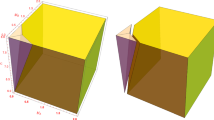Abstract
We model a typical Bell-test experimental situation by considering that Alice and Bob perform incompatible measurements in a sequential way, with mixed orders of execution. After emphasizing that order effects will generally produce a violation of the marginal laws, we derive an upper limit for the observed correlations. More precisely, when Alice’s and Bob’s measurements are compatible, the marginal laws are obeyed and Tsirelson’s bound limits the quantum correlations in the Bell-CHSH inequality to \(2\sqrt{2}\). On the other hand, when Alice and Bob perform incompatible mixed sequential measurements, the marginal laws are typically violated and the upper limit for the correlations is pushed up to \(2\sqrt{3}\). Considering that significant violations of the marginal laws (also called no-signaling conditions) have been observed in the data of numerous Bell-test experiments, the present analysis provides a possible mechanism for their appearance, when the protocols are such that Alice’s and Bob’s measurements can be assumed to be performed in a mixed sequential way. We, however, emphasize that this does not imply that a communication with superluminal effective speed would be possible.
Similar content being viewed by others
References
Adenier G, Khrennikov A (2007) Is the fair sampling assumption supported by EPR experiments? J Phys B At Mol Opt Phys 40:131–141
Adenier G, Khrennikov A (2017) Test of the no-signaling principle in the Hensen loophole-free CHSH experiment. Prog Phys 65:1600096
Aerts D (1982) Example of a macroscopical situation that violates Bell inequalities. Lettere al Nuovo Cimento 34:107–111
Aerts D (1990) An attempt to imagine parts of the reality of the micro-world. In: Mizerski J et al (eds) Problems in quantum physics II. Gdansk ’89. World Scientific Publishing Company, Singapore, pp 3–25
Aerts D, Sassoli de Bianchi M (2016) The extended Bloch representation of quantum mechanics: explaining superposition, interference and entanglement. J Math Phys 57:122110
Aerts D, Sassoli de Bianchi M (2017) Beyond-quantum modeling of question order effects and response replicability in psychological measurements. J Math Psychol 79:104–120
Aerts D, Sozzo S (2014a) Quantum entanglement in concept combinations. Int J Theor Phys 53:3587–3603
Aerts D, Sozzo S (2014b) Entanglement zoo II: examples in physics and cognition. In: Atmanspacher H, Haven E, Kitto K, Raine D (eds) Quantum interaction QI2013. Lecture notes in computer science, vol 8369. Springer, Berlin, pp 97–109
Aerts D, Arguëlles JA, Beltran L, Geriente S, Sassoli de Bianchi M, Sozzo S, Veloz T (2018a) Spin and wind directions II: a Bell state quantum model. Found Sci 23:337–365
Aerts D, Sassoli de Bianchi M, Sozzo S, Veloz M (2018b) On the conceptuality interpretation of quantum and relativity theories. Found Sci. https://doi.org/10.1007/s10699-018-9557-z
Aerts D, Arguëlles JA, Beltran L, Geriente S, Sassoli de Bianchi M, Sozzo S, Veloz T (2019) Quantum entanglement in physical and cognitive systems: a conceptual analysis and a general representation. arXiv:1903.09103 [q-bio.NC]
Ballentine LE, Jarrett JP (1987) Bell’s theorem: does quantum mechanics contradict relativity? Am J Phys 55:696–701. https://doi.org/10.1119/1.15059
Bednorz A (2017) Analysis of assumptions of recent tests of local realism. Phys Rev A 95:042118
Bell JS (1981) Bertlmann’s socks and the nature of reality. Journal de Physique Colloques 42(C2):C2-41–C2-62
Busemeyer JR, Bruza PD (2012) Quantum models of cognition and decision. Cambridge University Press, Cambridge
Clauser JF, Horne MA, Shimony A, Holt RA (1969) Proposed experiment to test local hidden-variable theories. Phys Rev Lett 23:880–884
De Raedt H, Michielsen K, Jin F (2012) Einstein–Podolsky–Rosen–Bohm laboratory experiments: data analysis and simulation. AIP Conf Proc 1424:55–66
De Raedt H, Jin F, Michielsen K (2013) Data analysis of Einstein–Podolsky–Rosen–Bohm laboratory experiments. In: Proceedings of SPIE 8832, The nature of light: what are photons?, vol 88321N. https://doi.org/10.1117/12.2021860
Harshman NL, Ranade KS (2011) Observables can be tailored to change the entanglement of any pure state. Phys Rev A 84:012303
Khalfin LA, Tsirelson BS (1985) Quantum and quasi-classical analogs of Bell inequalities. In: Lahti et al (eds) Symposium on the foundations of modern physics 1985. World Sci. Publ., Singapore, pp 441–460
Khrennikov A (2011) Violation of Bell’s inequality and postulate on simultaneous measurement of compatible observables. J Comput Theor Nanosci 8:1006–1010
Kupczynski M (2017) Is Einsteinian no-signalling violated in Bell tests? Open Phys 15:739–753. https://doi.org/10.1515/phys-2017-0087
Wang Z, Busemeyer JR (2013) A quantum question order model supported by empirical tests of an a priori and precise prediction. Top Cogn Sci 5(4):689–710
Zbinden H, Brendel J, Gisin N, Tittel W (2001) Experimental test of non-local quantum correlation in relativistic configurations. Phys Rev A 63:022111
Acknowledgements
I thank with pleasure Sandro Sozzo for his useful comments in relation to the content of this article.
Author information
Authors and Affiliations
Corresponding author
Ethics declarations
Conflict of interest
The author declares that he has no conflict of interest.
Ethical approval
This article does not contain any studies with human participants performed by the author.
Additional information
Communicated by F. Holik.
Publisher's Note
Springer Nature remains neutral with regard to jurisdictional claims in published maps and institutional affiliations.
Rights and permissions
About this article
Cite this article
Sassoli de Bianchi, M. Violation of CHSH inequality and marginal laws in mixed sequential measurements with order effects. Soft Comput 24, 10231–10238 (2020). https://doi.org/10.1007/s00500-019-04186-x
Published:
Issue Date:
DOI: https://doi.org/10.1007/s00500-019-04186-x




